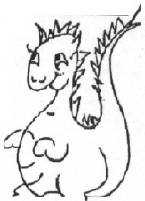Part 3 of several
The Mysterious And Unpredictable RND
Bob Albrecht and George Firedrake
From a book of the same name by Dymax Publishing Company; copyright ©1980 Dymax. Permission to reprint by teachers for classroom use is granted.
Editor's Note: You may reach Bob & George by mail at:
P. O. Box 310
Menlo Park, CA
94025
Dice Roller
OK PET, let's roll one die a bunch of times. We will simulate rolling an ordinary six-sided die. For each roll, the possible outcomes are 1 or 2 or 3 or 4 or 5 or 6.
100 REM***DICE ROLLER #1 200 REM***FIND OUT HOW MANY ROLLS 210 PRINT "[CLR]" ; 220 INPUT "HOW MANY DICE ROLLS" ; N 400 REM***ROLL ONE DIE N TIMES 410 FOR K = 1 TO N 420 DIE = INT(6*RN(1)) + 1 430 PRINT DIE, 440 NEXT K 450 PRINT 999 END
For many dice games or other uses of dice, we roll two dice. The outcome of a roll is the total of the "spots" or number showing on both dice.

Your turn. Tell PET how to simulate rolling two dice.
Exercise 11. Write a program to simulate rolling two dice, N times.
HOW MANY DICE ROLLS? 20 8 7 3 10 9 9 8 4 6 7 10 11 5 6 5 6 READY ▪

When we roll two dice, the possible outcomes are numbers from 2 to 12. However, they are not equally likely.
- There is only one way to get 2.

- There are two ways to get 3.

- There are several ways to get 7.

And several more!
Exercise 12. Complete the following table showing the number of different ways to get each possible outcome (2 through 12) in rolling two 6-sided dice.
| OUTCOME | NUMBER OF WAYS |
| 2 | 1 |
| 3 | 2 |
| 4 | 5 |
| 5 | — |
| 6 | — |
| 7 | — |
| 8 | — |
| 9 | — |
| 10 | — |
| 11 | — |
| 12 | — |
Next, we would like to compute proportions, as defined below (X is any outcome, 2 through 12).


Or, since the total for all outcomes is 36,


Exercise 13. Complete the following table (use a calculator!)
| OUTCOME | NUMBER OF WAYS | PROPORTION |
| 2 | 1 | 1/36 = .0278 |
| 3 | 2 | 2/36 = .0556 |
| 4 | 3 | 3/36 = .0833 |
| 5 | — | ______________ |
| 6 | — | ______________ |
| 7 | — | ______________ |
| 8 | — | ______________ |
| 9 | — | ______________ |
| 10 | — | ______________ |
| 11 | — | ______________ |
| 12 | — | ______________ |
If we flip a coin, the probability of getting HEADS is ½ = .5. What is the probability of getting TAILS?
Yes, we are leading up to a heavy exercise. But, you can probably do it!
Exercise 14. Write a program to simulate N rolls of two dice. Don't print the results. Instead, count the number of occurrences of each possible outcome (2 through 12), then print this information and also print the proportion of each outcome. Huh? For N rolls, the proportion for outcome X is:

We did it, we wrote the program and ran it. Here is what happened.

OUTCOME FREQUENCY PROPORTION 2 23 .024 3 62 .062 4 81 .081 5 109 .109 6 140 .14 7 142 .142 8 137 .137 9 126 .126 10 80 .08 11 72 .072 12 27 .027
If you have the time, try 10000 rolls, or 20000 rolls, or even 100000 rolls. Compare the proportions with the proportions you wrote down for Exercise 13. Or, compare with our answers for Exercise 13.